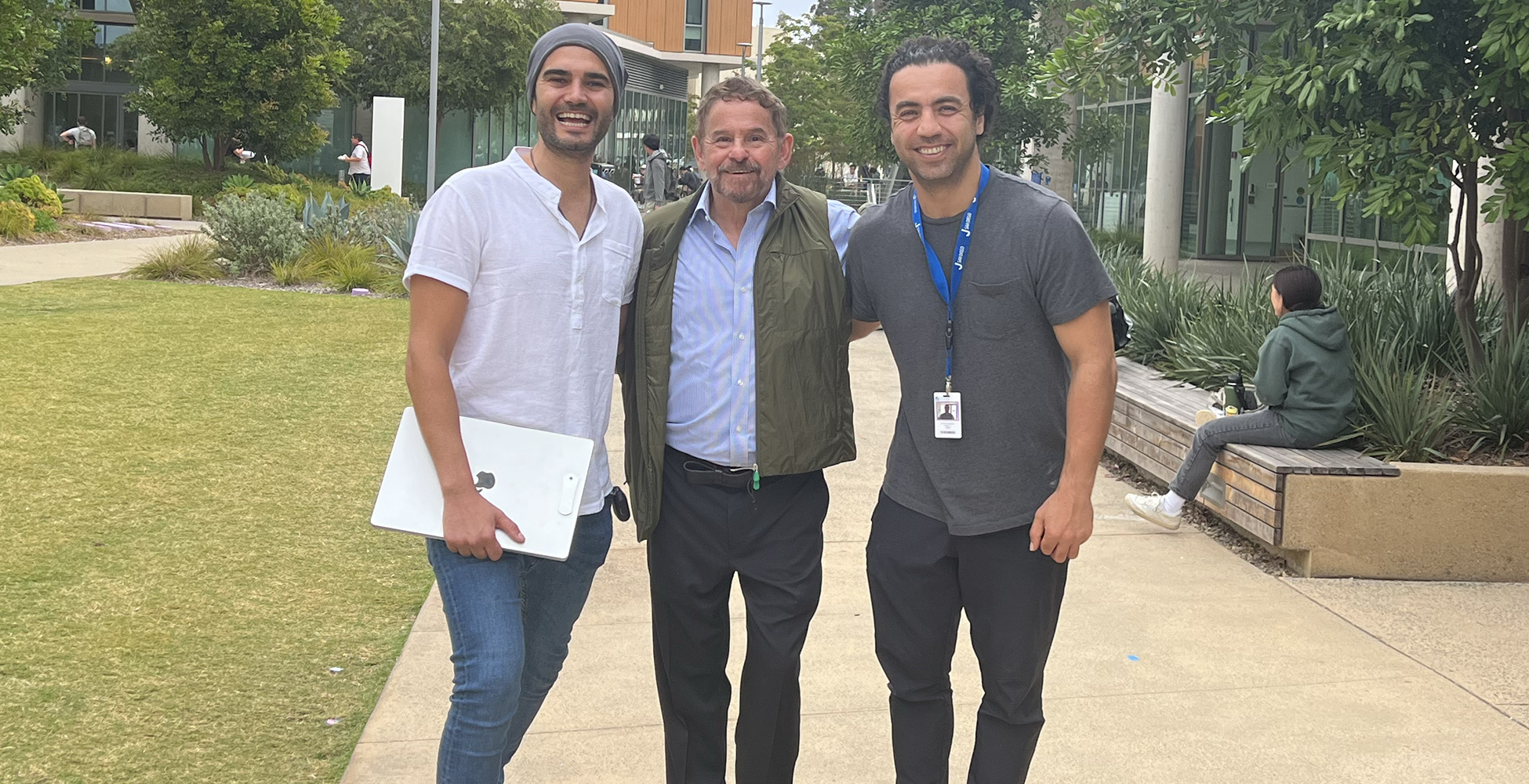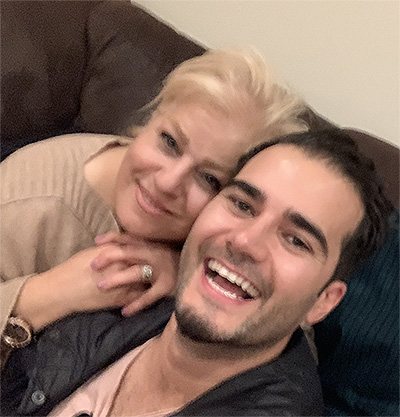Passion and Persistence Fuel Biotech Startup

It’s not unusual to find Farshad Tehrani pacing the halls of the Qualcomm Institute’s Atkinson Hall late into the evening.
“Right now, I’m focused on what’s needed to scale the company—not only advancing the technology and securing funding, but also building a team of top-notch employees, advisors and consultants,” he said. “It’s a 24/7 endeavor.”
In simple terms, the company, called AquilX, seeks to commercialize promising cutting-edge medical technology. Its wearable device offers a “lab under the skin” that can conveniently and continuously track levels of biomarkers such as alcohol, lactate, glucose, and other substances.
But, for Tehrani, AquilX also represents so much more.
First Steps
Tehrani clearly recalls the moment that launched his journey about seven years ago, around the time he came to the U.S. from Iran. He was sitting across the table from his mother, who is diabetic. “She was pricking her finger to check her blood sugar, and her eyes were full of pain,” he said. “I thought, ‘There should be an easier solution.’ Everything started from that moment.”
While pursuing a master’s degree at California State University, Northridge, he began exploring alternative ways to measure “analytes” or biomarkers in the body. In Tehrani’s view, any measurement device using blood would require insertion devices, and these would never be pain-free. More inventive approaches were needed.
As a master’s student, he worked on two projects creating strips to measure biomarkers in saliva. For his doctoral work, he joined the nanotechnology laboratory of UC San Diego SAIC Endowed Chair Professor Joseph Wang in the Jacobs School of Engineering.
He couldn’t be happier with the choice: “The lab is filled with world-class scientists where I found my early co-founder, and my training from Dr. Wang, who is widely respected in academia and industry, was invaluable.”
Emerging Technology
As a Ph.D. student in Wang’s lab, Tehrani first continued to pursue saliva as a potential biomarker, also considering sweat as another avenue. Ultimately, he decided to bypass both as the basis for his product and go in another direction.

“While there are elegant proof-of-concept studies on sweat as a biomarker, every person has a different skin thickness, pore size and rate of precipitation,” he said. “Analytes are all over the place, so it’s hard to find a reliable system and calibrate what we are measuring.”
The alternative? Tehrani turned his attention to interstitial fluid, which is found in the spaces around cells. Biomarkers in interstitial fluid are relatively closer than saliva or sweat to the uniformity of blood, which has been the field’s gold standard. In addition, interstitial fluid can be accessed just below the surface of the skin, at depths much shallower than blood—and nerve endings—making access potentially pain-free.
To access interstitial fluid, microneedles offered a cutting-edge solution. Named one of the “Top Emerging Technologies for 2020” by a joint committee of the World Economic Forum and Scientific American, microneedles are typically about the depth of a sheet of paper and the width of human hair. Even on this diminutive scale, they are able to penetrate the dead top layer of skin and reach the second layer, where interstitial fluid lies waiting.
Enlisting the help of Wang and other colleagues, including Professor Patrick Mercier, co-director of the UC San Diego Center for Wearable Sensors, Tehrani began to explore how to harness this technology to reach his goals.
Engineering Solutions
How could the team make a device capable of continuously monitoring biomarkers such as blood sugar, alcohol and lactate levels, integrating the device’s elements in a way that the sensor functions seamlessly with molecular-level accuracy on a freely behaving human body? And how could this device be packaged in a way that the patients find not only reliable, but also convenient?
Ultimately, the researchers devised a compact device in two parts: a microneedle patch connected to a case of electronics. Worn on the upper arm, the patch contains microneedles with tips coated with enzymes. The electronics case includes a battery, electronic sensors and a wireless transmitter.
When the enzymes on the microneedles come into contact with the biomarkers in the interstitial fluid, small electric currents are generated. These currents are transmitted to the electronics box, then analyzed by the electronic sensors and communicated wirelessly to a smartphone. There, a dedicated app displays results.
To further enhance usability, the microneedle patch is disposable and detachable from the electronic case, which can be reused and charged on any wireless smartphone charging pad. The patch itself is only about the size of a short stack of quarters, and the team continues to seek ways to reduce its volume.
The Roll Out
In presenting the work to the scientific community, the team has published papers on its approach in The Nature Reviews Neurology (https://www.nature.com/articles/s41582-022-00674-1 ) (May 2022) and Nature Biomedical Engineering (May 2022).
The Nature Biomedical Engineering paper reported results from testing the device with five volunteers. As the volunteers went through their day exercising, eating a meal, and drinking a glass of wine, the device measured not only volunteers’ blood sugar but also their levels of either alcohol or lactate. These measurements closely reflected those from a commercial blood glucose monitor, Breathalyzer, and lab blood lactate test.
“With our wearable, people can see the interplay between their glucose spikes or dips with their diet, exercise, and drinking of alcoholic beverages,” he said in a UC San Diego press release published at the time. “That could add to their quality of life as well.”
Tehrani emphasizes one example of the device’s potential impact, which is for over 400 million diabetics around the world, is just the beginning. The device could also be adapted to play a role in monitoring and managing Parkinson’s disease (publication found at nature.com/articles/s41551-022-00887-1), therapeutic drug effectiveness (https://pubs.acs.org/doi/10.1021/acs.analchem.2c00829 ), Alcohol Use Disorder (AUD), sepsis, heart attack, athletic performance/training, and more.
“The potential is tremendous,” said Tehrani. “We want to combine the power of artificial intelligence, continuous monitoring and data fusion to create a future where people can have personalized medicine with their phone opening possibilities towards healthcare democratization and elimination of healthcare discrepancies. What we call ‘personal healthcare’ is the ultimate vision.”
At Home at QI
While the process of discovery has had many rewards for Tehrani—including a doctoral degree from UC San Diego in December 2021—he is continuing to champion the commercial future of the device. To do so, in February Tehrani and Hazhir Teymourian, a former postdoctoral fellow in Wang’s lab, co-founded AquilX.
The pair chose to locate the company in the QI Innovation Space in UC San Diego’s Atkinson Building and added another co-founder, Brian Wuerstle, a former grad student in Mercier’s lab.
“The Qualcomm Institute is just fantastic,” Tehrani said. “The space, environment, and people make it an especially nurturing place for innovation to arise. Logistically, Qualcomm Institute is perfect for us. Why? Because we have a nano clean room facility right there. We have a premium prototyping facility and circuit lab access. We have space for meetings. On top of that, QI’s director, Ramesh Rao, has been extremely supportive.”
Throughout his journey, Tehrani has not lost sight of his ultimate motivation—to help people like his mother. “My core commitment is to make a difference, to be a contributor to society, to the world’s population,” he said, “during this short period I’m on this planet.”
Learn more about the Qualcomm Institute Innovation Space.